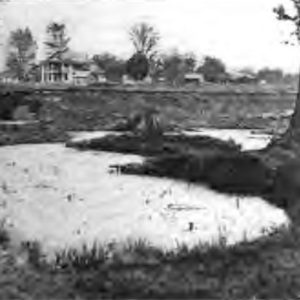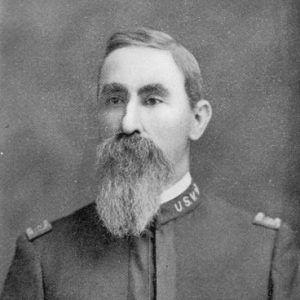calsfoundation@cals.org
Malaria
Malaria is a serious infectious disease caused by a single-celled parasite known as a plasmodium, which is generally spread through mosquito bites. This disease caused incalculable suffering for thousands of Arkansans and other Southerners through the early twentieth century.
Symptoms of malaria include high fever, chills, profuse sweating, malaise, headaches, nausea, vomiting, and diarrhea. These symptoms can appear within a week of initial infection but can vary with the different types of parasites. Complications can include anemia, liver failure, kidney failure, and breathing problems. Patients can suffer relapses years after the initial infection. If untreated, malaria can cause death. Along with pellagra and hookworm, malaria was one of three diseases whose symptoms contributed to the false stereotype of Southerners as lazy in the late nineteenth and early twentieth centuries.
The parasites responsible for malaria did not originate in North America but rather in Africa and soon spread to portions of Europe. One study suggests that malaria appeared in the area that later became Arkansas as early as 1541 with the expedition of Hernando de Soto. By the eighteenth century, as the population of Europeans and African slaves increased in the Americas, the instances of malaria increased as well. Visitors to Arkansas Post in the 1720s and later noted unbearable swarms of mosquitoes in that region. Reports from Arkansas Post in 1819, as the Arkansas Territory was created, suggest that a malaria epidemic was sweeping the region. Over time, most malaria outbreaks in Arkansas emerged in the eastern part of the state.
Quinine had emerged as a treatment for malaria by the 1700s, and various tonics and potions of questionable value claiming to treat malaria became common features of traveling medicine shows in the nineteenth-century South. By the late 1800s, however, medical science had not been able to determine how malaria spread. In addition to the immense human toll, estimates put economic losses to the South from malaria at approximately $50 million per year.
In 1882, Dr. Zaphney Orto conducted studies with mosquitoes at Walnut Ridge (Lawrence County). These efforts proved a connection between malaria and mosquitoes. This led to further studies of the disease and inspired efforts to eliminate mosquitoes. A campaign to eradicate mosquitoes, a joint effort sponsored by the federal Public Health Service and the Rockefeller Foundation, was conducted in Crossett (Ashley County) in 1916 and showed a seventy-two-percent decrease in malaria cases over a one-year period. Crossett quickly became a model for other eradication campaigns.
In spite of these advances, instances of malaria were often underreported, often due to a lack of access to physicians and the use of over-the-counter medications believed to treat the disease. Throughout most of the 1920s and 1930s, Arkansas reported the most malaria-related deaths of any state. Researchers continued to urge mosquito eradication programs in communities across the state in the 1930s and 1940s, including recommending that residents install screens in windows, porches, and doors and use mosquito repellants and even smudge pots to repel mosquitoes.
By the mid-1940s, Arkansas doctors still reported more than 2,000 new cases annually, though greatly reduced from earlier levels. After World War II, the federal government sponsored an aggressive mosquito eradication campaign across Arkansas and the South, spraying hundreds of thousands of homes between 1947 and 1953 with the pesticide DDT. By 1951, no cases of malaria were reported in Arkansas. Though mosquitoes remained common in Arkansas, DDT spraying was discontinued in the 1960s as the serious health risks of the pesticide became more widely understood.
Further advances in medicine led to new drugs to treat malaria by the mid-twentieth century. These same drugs, including primaquine, chloroquine, and doxycycline, are often given to prevent malaria as well. In spite of intense research, no effective vaccine has yet been discovered.
While malaria remains a serious threat to public health in developing nations, it has been all but eliminated across the United States. From 1998 to 2007, the Arkansas Department of Health (ADH) reported only between two and eight cases per year in the state. None of these cases originated within the United States. Between 2011 and 2023, there were forty-six cases of malaria diagnosed in the state, all of which were contracted outside of Arkansas. In 2023, federal health officials announced the first instances of malaria transmitted inside the United States since 2023, with cases diagnosed in Florida and Texas. Rising temperatures due to global warming have lengthened the season during which mosquitoes are active and thus increased the threat of mosquito-borne illnesses such as malaria. In October 2023, the ADH announced that a Saline County resident tested positive for malaria without having traveled out of country, making this the first case of locally acquired malaria in many years.
For additional information:
Barnes, Jeffrey K. “Arkansas Arthropods in History and Folklore.” University of Arkansas Arthropod Museum. http://entomology.uark.edu/museum/folk.html (accessed April 11, 2022).
Bell, Andrew McIlwaine. Mosquito Soldiers: Malaria, Yellow Fever, and the Course of the American Civil War. Baton Rougue: Louisiana State University Press, 2010.
Courtney, Ashleah P., Bobby L. Boyanton Jr., Paige V. Strebeck, et al. “Locally Acquired (Autochthonous) Mosquito-Transmitted Plasmodium vivax Malaria— Saline County, Arkansas, September 2023.” Morbidity and Mortality Weekly Report 73 (October 24, 2024): 946–949. DOI: http://dx.doi.org/10.15585/mmwr.mm7342a2 (accessed October 28, 2024).
Hofsommer, Don L. “St. Louis Southwestern Railway’s Campaign against Malaria in Arkansas and Texas.” Arkansas Historical Quarterly 62 (Summer 2003): 182–193.
Lancaster, Bob. “Malaria’s Mark.” Arkansas Times, January 1988, 34–37, 52, 54, 56.
Ly, My. “Experts Warn of Malaria Risks, Say to Keep Mosquitoes Away.” Arkansas Democrat-Gazette, July 10, 2023, pp. 1B, 2B. Online at https://www.arkansasonline.com/news/2023/jul/10/experts-warn-of-malaria-risks-say-to-keep/ (accessed July 10, 2023).
———. “State Sees 1st Locally Acquired Malaria Case in Saline Count.” Arkansas Democrat-Gazette, October 5, 2023, pp. 1A, 8A. Online at https://www.arkansasonline.com/news/2023/oct/05/arkansas-reports-first-case-of-locally-contracted/ (accessed October 5, 2023).
Schaeffer, Kelly. “Disease and de Soto: A Bioarchaeological Approach to the Introduction of Malaria to the Southeast US.” MA thesis, University of Arkansas, Fayetteville, 2019. Online at https://scholarworks.uark.edu/etd/3173/ (accessed July 6, 2022).
Kenneth Bridges
South Arkansas Community College




 Malaria Tonic Ad
Malaria Tonic Ad  Malaria Control in Hamburg
Malaria Control in Hamburg  Malaria Control in Hamburg
Malaria Control in Hamburg  Zaphney Orto
Zaphney Orto  Henry Thibault
Henry Thibault 



Comments
No comments on this entry yet.